07.27.10
Posted in Non-US Weather, Weather News at 10:59 pm by Rebekah
This week’s post in the global weather and climate series features Moscow, Russia.
-
-
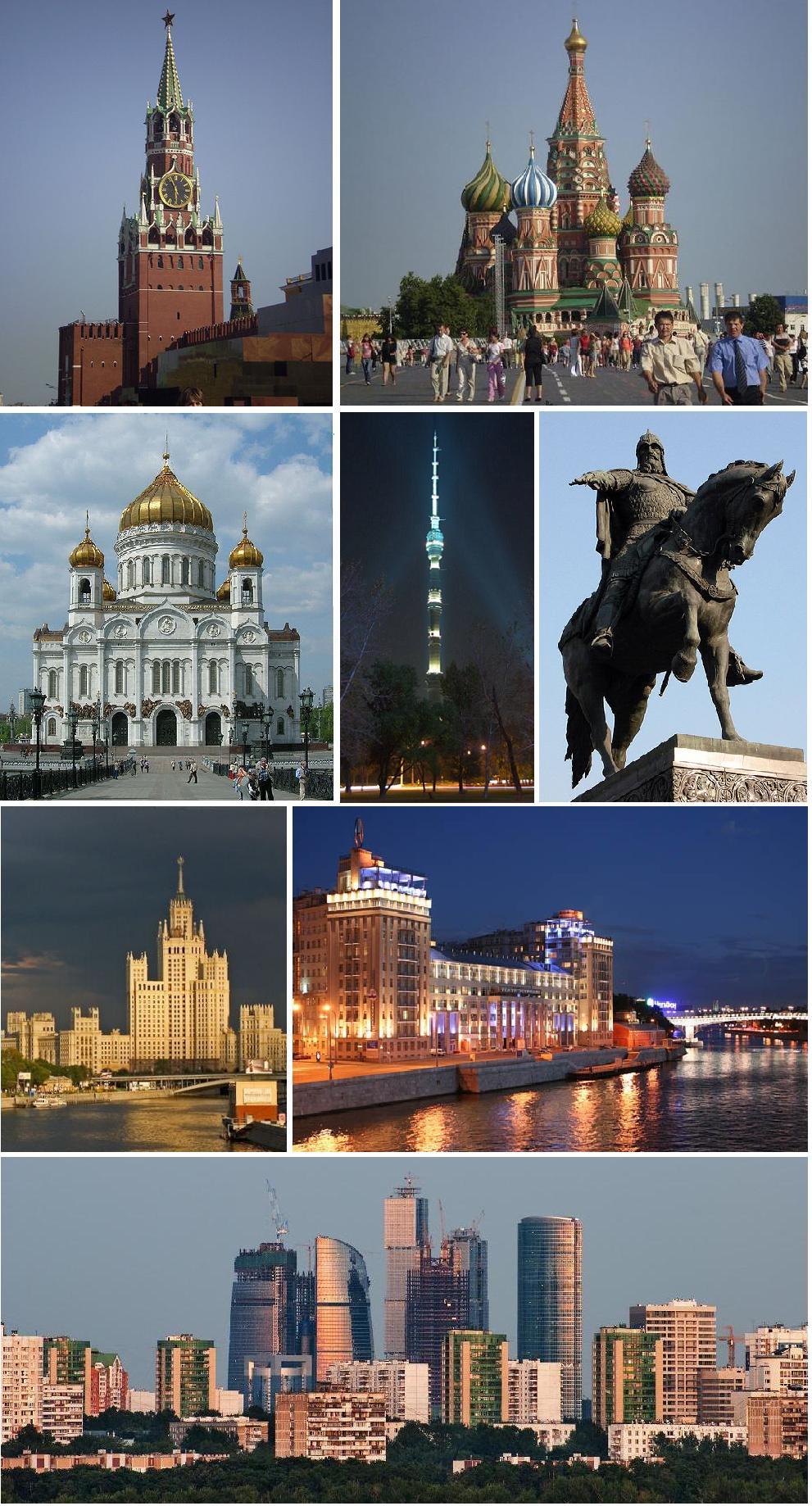
Moscow, Russia (click to enlarge). Courtesy of Wikipedia.
The most populous city in Russia and second largest in Europe (only London’s metro is larger), Moscow is located in west central Russia, on the Moskva River. By most definitions, Moscow is in eastern Europe rather than in Asia. Moscow, dating back to at least the 12th century, was the capital city of the U.S.S.R. and is currently the capital of Russia. Moscow was the site of the 1980 summer Olympic Games, which were boycotted by the United States and several western European countries. Moscow is home to about 10.6 million people.
A few more facts about Moscow (from Wikipedia):
- Time zone: Moscow Standard Time (UTC+3) or Moscow Summer Time (UTC+4)
- Elevation: 512 to 837 ft above mean sea level
- Climate zone: Humid continental (warm, somewhat humid summers and long, cold winters)
- Average high temperature: 49 °F (9 °C)
- Average low temperature: 35 °F (2 °C)
- Record high temperature: 99 °F (37 °C) – recorded on 26 July 2010!
- Record low temperature: -44 °F (-42 °C)
- Average annual precipitation: 28 inches (700 mm)
Current weather: Russia is currently in the midst of a record heat wave; as noted above, the all-time record high temperature in Moscow (over 130 years of records) was set yesterday, at 99.3 °F (37.4 °C), and it’s possible that that record could break yet again over the next few days.
Thursday’s GFS temperature forecast (in Celsius), for 4 pm local Moscow time (Moscow can be found just south of Belarus’ northern border and just west of Ukraine’s eastern border):
(Courtesy of Weather Online UK; click to enlarge)
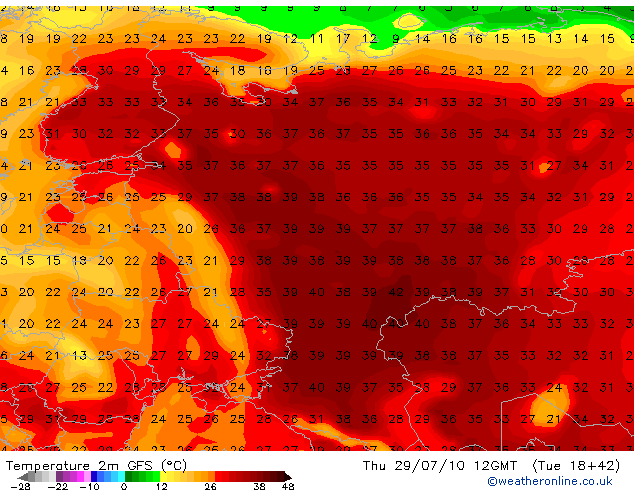
Note the forecast high is for 37 to 39 °C! Moscow’s normal high for this time of year is around 23 °C.
Why is it so hot?
I’m a little unfamiliar with Russian microclimates and geography, but one big reason is that there is a large ridge of high pressure that has built across western Russia (see 500 mb 00Z initialization of the ECMWF model, below, valid for 4 am Wednesday, local Moscow time).
(Courtesy of Weather Online UK; click to enlarge)

This ridge is associated with a surface high, seen below (for the same time as the above map).
(Courtesy of Weather Online UK; click to enlarge)
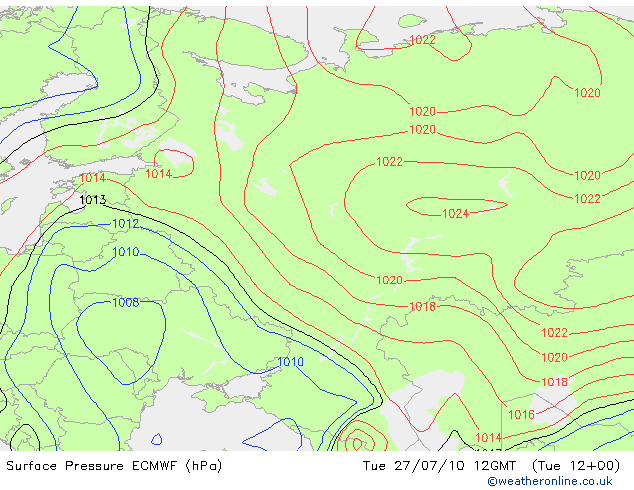
This high pressure has brought and will continue to bring, for the next several days, dry, sinking air and warm south / southeasterly winds to western Russia.
To make matters worse, there are also some 60 forest and peat fires ongoing near Moscow, covering about 145 acres, according to the BBC. Doctors have advised residents to keep their windows closed and to wear masks to avoid inhaling ash particles as the smoke and smog is so thick.
The sinking air associated with the high pressure is a large part of the problem, as it has prevented much of the smoke from dissipating and has kept it trapped close to the surface.
For more information on Moscow, here’s a link to Wikipedia.
For weather maps and information on current and forecast Moscow weather, see Weather Online UK (collection of maps and weather information for all over the world) and the Hydrometeorological Center of Russia (Russia’s national weather service – it is in English!).
Next Tuesday I plan to take a look at the climate and weather in another part of the globe. As always, if you have any comments or suggestions for future cities, please leave a comment on this post!
Permalink
07.23.10
Posted in Tropical Weather, Weather News at 6:59 pm by Rebekah
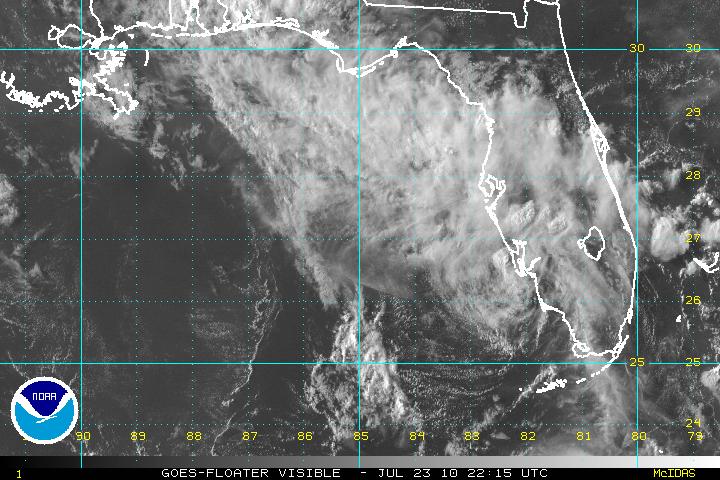
Tropical Storm Bonnie formed just southeast of Florida last night, and made landfall over southern Florida this morning.
The above visible satellite image, from the National Hurricane Center (NHC), shows the remains of Bonnie entering the Gulf of Mexico this evening.
Although the NHC initially forecast Bonnie to strengthen to a tropical storm again before making landfall in Louisiana, an upper-level high over the southeastern U.S. and an upper-level low over the Gulf of Mexico are working to steer the tropical depression towards an area of wind shear, which will prevent Bonnie from strengthening.
The 250mb map below (click to enlarge), from the UCAR RAP, indicates the upper-level high by the blue, clockwise streamlines and the upper-level low by the blue, counter-clockwise streamlines. The orange and yellow highlighted area over the northeastern Gulf of Mexico represents an upper-level jet streak (enhancing the wind shear across Bonnie’s track), with winds going from southeast to northwest.

Permalink
07.08.10
Posted in Tropical Weather, Weather News at 1:01 pm by Rebekah
Late last night a new tropical depression formed off of the south Texas / northeastern Mexican coast. Tropical Depression 2 (TD2) was forecast by the National Hurricane Center to briefly become Tropical Storm Bonnie by this morning, but at 10:15 am CDT, TD2 made landfall near Brownsville, Texas.
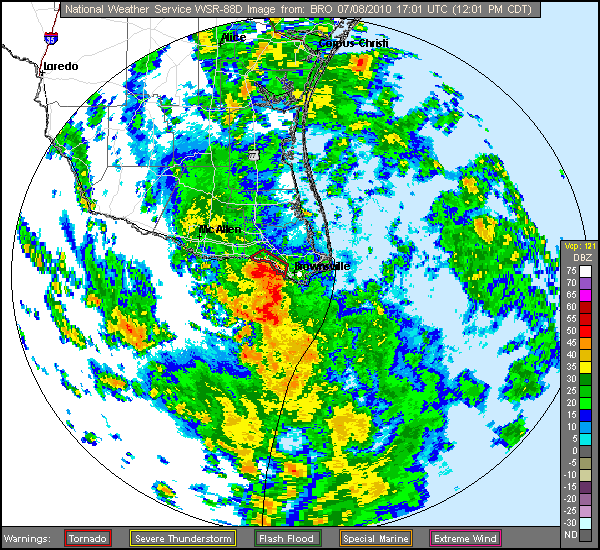
Brownsville, Texas radar loop, from the NWS Brownsville office.
The primary threat with TD2 is heavy rainfall; this rain is coming down on areas already saturated by former Hurricane Alex last week.
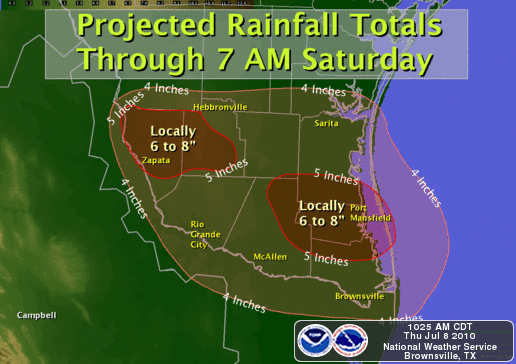
Rain forecast by NWS Brownsville office.
The remnant low will likely follow a similar path to that of Alex, tracking northward up towards Oklahoma, interacting with a front and bringing more showers and thunderstorms to the Southern Plains.
Permalink
07.06.10
Posted in Non-US Weather, Weather News at 10:37 pm by Rebekah
This week’s post in the global weather and climate series features Johannesburg, South Africa.
-
-
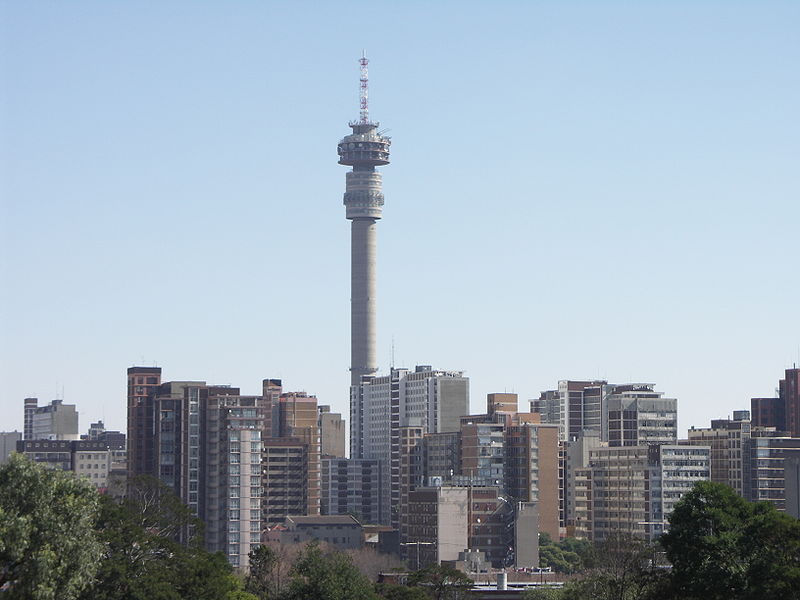
Hillbrow Tower in Johannesburg, South Africa. Courtesy of Wikipedia.
The provincial capital of Gauteng, the wealthiest province in South Africa, Johannesburg is located at about 26 °S, 28 °E. Johannesburg’s economy is centered around the lucrative gold and diamond trade. The city is also hosting the 2010 FIFA World Cup final, which is coming up this Sunday between the Netherlands and either Germany or Spain. Johannesburg is home to 3.9 million people (6.3 million in the metro).
A few more facts about Johannesburg (from Wikipedia):
- Time zone: South Africa Standard Time (UTC+2)
- Elevation: 5,751 ft above mean sea level
- Climate zone: Subtropical highland
- Average high temperature: 71 °F (22 °C)
- Average low temperature: 50 °F (10 °C)
- Average annual precipitation: 28 inches (713 mm)
Current weather: It is currently winter in Johannesburg, so the days are sunny and mild and in the 60s with lows near freezing. South Africa is at a latitude that is frequently dominated by high pressure, and this time is no exception, with a surface high in place and a ridge aloft, thus keeping the weather fairly pleasant (though nights could be cold). Sunday’s Weather Underground forecast for the World Cup calls for clear skies with a high of 62 °F and a low of 35 °F, while the South African Weather Service forecast calls for a high of 18 °C (64 °F) and a low of 1 °C (34 °C).
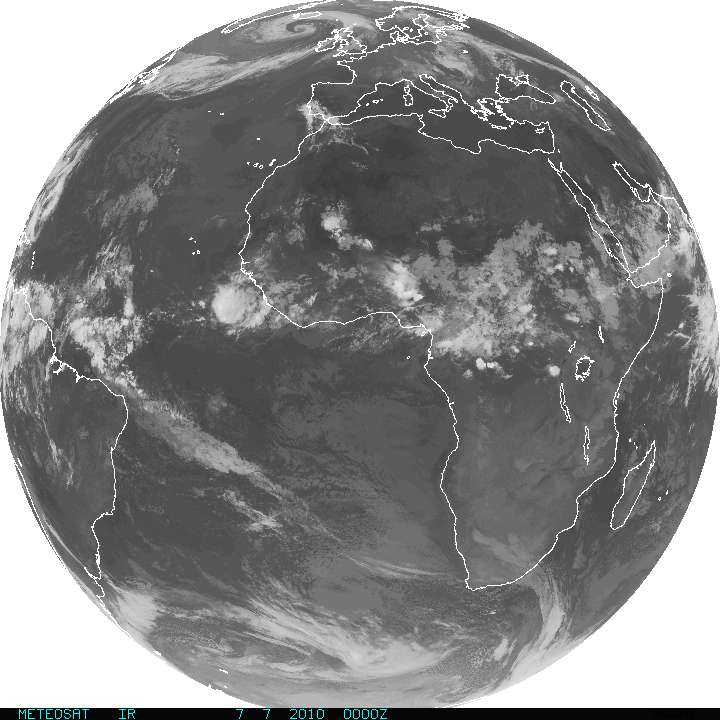
00Z (2 AM in Johannesburg, 5 PM in Los Angeles) METEOSAT infrared satellite image of Africa, showing clear skies over southern Africa. Courtesy of the GOES website. Click to enlarge.
For more information on Johannesburg, here’s a link to Wikipedia.
For weather maps and information on current and forecast Johannesburg weather, see the South African Weather Service site.
Next Tuesday I plan to take a look at the climate and weather in another part of the globe. As always, if you have any comments or suggestions for future cities, please leave a comment on this post!
Permalink
07.02.10
Posted in Tropical Weather, Weather News at 7:36 pm by Rebekah
Rain is expected over much of the central US, especially south central. See also this weather graphic from the Wichita, Kansas office:
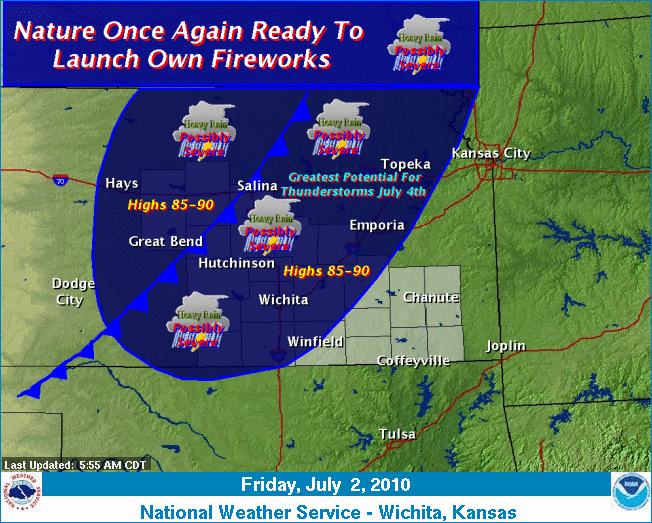
Their discussion starts: “In what is turning into seemingly an annual event…Nature is getting ready to launch fireworks of her own once again.”
(Referring to it raining last year…I think Norman hadn’t seen rain in about 2 or 3 weeks, when we got some thunderstorms on the 4th!)
Permalink
« Previous Page — « Previous entries « Previous Page · Next Page » Next entries » — Next Page »










